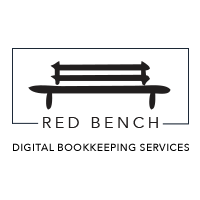
The Red Bench can help modernize your bookkeeping functions.
From pen and paper to digital convenience we can make it happen!

5 things to remember when you have a new employee.
If you’re hiring a new employee, congratulations! It’s important to start off on the right foot as an employer by making sure you follow all of the legal rules that now apply to you. From tax forms to government registrations to insurance requirements and more, being an employer carries a number of new obligations. You’ll find our to-do list for new employers below.

- Have each employee fill out IRS Form W-4, Withholding Allowance Certificate. On the W-4 form, employees tell you how many allowances they are claiming for tax purposes, so that you can withhold the correct amount of tax from their paychecks. (You don’t have to file the form with the IRS.) You can find this form at www.irs.gov. You should ask employees to fill out a new W-4 form each year if they want to change their allowances.
- Fill out Form I-9, Employment Eligibility Verification for each new employee. U.S. Citizenship and Immigration Services (USCIS, formerly known as the INS) requires employers to use this form to verify that every employee they hire is eligible to work in the United States. (You don’t have to file this form with the USCIS, but you must keep it in your files for three years and make it available for inspection by officials of Immigration and Customs Enforcement, known as ICE.) You can obtain the form online at www.uscis.gov. Note that these filled out forms should be kept in a separate I-9 folder for all employees — not in each employee’s personnel file.
- Report each new employee to your state’s new hire reporting agency. The new hire reporting program requires employers to report information on all new employees for the purpose of locating parents who owe child support. Each state has a different new hire reporting agency. To find the name and address of your state’s new hire reporting agency,see the State New Hire Reporting page at the Administration for Children & Families website (www.acf.hhs.gov).
- Post required notices. Several government agencies require employers to post notices providing information on worker rights for their employees. For information on required federal posters, go to the Department of Labor website at www.dol.gov/elaws/posters.htm. The DOL’s “Poster Advisor” will help you determine which posters you must display in your workplace. In addition, you must comply with your state department of labor’s poster requirements. A list of state departments of labor is included on the federal Department of Labor’s website.
- File IRS Form 940 each year. You must file IRS Form 940 to report your federal unemployment tax for any year in which you paid wages of $1,500 or more in any quarter or for any year in which an employee worked for you in any 20 or more different weeks of the year. You can find the form at www.irs.gov.
More that we recommend.
Adopt workplace safety measures.
Virtually every employer must comply with the requirements of the Occupational Safety and Health Act (OSHA) by, among other things, providing a workplace free of hazards, training employees to do their jobs safely, notifying government administrators about serious workplace accidents, and keeping detailed safety records. For information on these rules, go to website of the Occupational Safety and Health Administration at www.osha.gov.
Create an employee handbook.
Although not required, it is an excellent idea to have a handbook describing your business’s employee policies and making it clear that employment is at will unless an employee has signed a written employment contract.
Set up personnel files.
For each employee you hire, create a file in which to keep job-related documents, such as job applications, employment offers, IRS Form W-4, performance evaluations, and sign-up forms for employee benefits. Medical records should be kept in a separate, confidential file, in a locked cabinet. And you should store I-9 Forms, which document an employee’s immigration status, in a separate file as well.
Set up employee benefits.
If your business has established employee benefit programs such as health insurance or a 401(k) plan, you’ll need a sign-up procedure so employees can enroll, name their dependents, and select options.
THINGS WE DO THAT CAN CHANGE YOUR LIFE
Our accounting software with all the time-saving tools you need to grow your business.
Red Bench is always reliable and our experts are here to support you 24/7.







